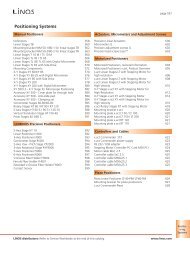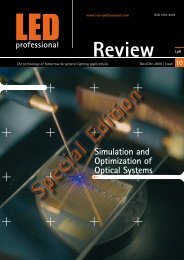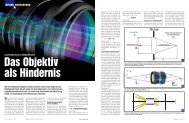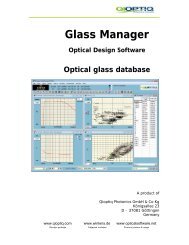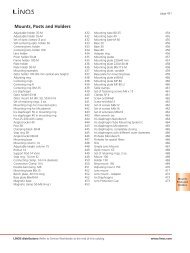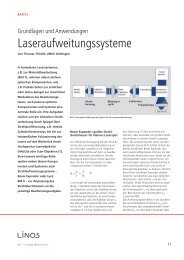You also want an ePaper? Increase the reach of your titles
YUMPU automatically turns print PDFs into web optimized ePapers that Google loves.
page 100 <strong>Optical</strong> <strong>Systems</strong><br />
Introduction to Laser beam Homogenizer<br />
Many applications, e.g. from microscopy and material processing,<br />
require a very even distribution of the illuminating light.<br />
For this purpose, micro lens based homogenizers are available nowadays<br />
for numerous light sources, ranging from excimer lasers to high<br />
power LEDs.<br />
Two general types are distinguished, Non-Imaging and Imaging<br />
Homogenizers. Both types split the incident beam into small sub<br />
beams. This is achieved by passage either through arrays of cylindrical<br />
lenses in a crossed configuration, or through arrays of micro lenses.<br />
The sub beams are then superimposed by a spherical lens in its focal<br />
plane, leading to a homogeneously illuminated field. This spherical<br />
lens is called Fourier lens, as it effectively performs a two dimensional<br />
Fourier transformation.<br />
The application itself should be considered when choosing between<br />
Non-Imaging and Imaging Homogenizer. As an orientation aid one<br />
should consider the Fresnel number, which is defined for micro lens<br />
homogenizers by<br />
where P LA represents the pitch of the micro lens array, D FT the size of<br />
the flat top in the plane of homogenization, f FL the focal length of the<br />
Fourier lens, and λ is the wavelength. The Fresnel number is the most<br />
important determinant for laser beam homogenizers based on micro<br />
lens arrays. As a general rule, the uniformity of the flat top increases<br />
with higher Fresnel numbers.<br />
Non-imaging homogenizers<br />
Non-Imaging Homogenizers are built from one micro lens array and<br />
one spherical lens (see figure above). The plane of homogenization<br />
lies in the focal plane of the Fourier lens (FL), the size of the<br />
homogeneously illuminated area is determined by:<br />
LINOS, USA<br />
Phone +1 (508) 478-6200<br />
E-mail info@linos.com<br />
LINOS, UK<br />
Phone +44 (0) 1908 262525<br />
E-mail sales@linos.co.uk<br />
Non-Imaging Homogenizers often show dominant diffraction effects<br />
due to Fresnel diffraction at the micro lens array. In practice, Fresnel<br />
numbers of FN >10, or better FN >100, lead to homogeneous intensities.<br />
Due to the connection of the Fresnel number with the size of the<br />
flat top, Non-Imaging Homogenizers are the first choice for illuminating<br />
large areas. For small Fresnel numbers of FN < 10, or when a<br />
very even distribution is required, Imaging Homogenizers should be<br />
chosen..<br />
Imaging homogenizers:<br />
Imaging Homogenizers are built from two micro lens arrays and one<br />
spherical lens (see figure above). The plane of homogenization lies in<br />
the focal plane of the Fourier lens (FL), the size of the homogenized<br />
area is defined by:<br />
LINOS, France<br />
Phone +33 (0)4 72 52 04 20<br />
E-mail info-fr@linos.com<br />
with<br />
Here, a 12 denotes the distance between the two micro lens arrays. As<br />
with Non-Imaging Homogenizers, the incident beam is split into many<br />
small sub beams with the first micro lens array. The second micro lens<br />
array then acts, in combination with the spherical lens, like an array<br />
of objective lenses, overlapping the sub beams of the first array in the<br />
plane of homogenization. As the size of the flat top depends in this<br />
case on the distance between the two arrays, it can easily be adjusted<br />
by moving the second array. However, great care has to be taken that<br />
the second array is not moved into the focus plane of the first array,<br />
where it could be damaged by focussed high energy laser light.<br />
Imaging Homogenizers usually use micro lens arrays of identical pitch.<br />
The shape of the flat top is determined by the shape of the micro<br />
lenses (e.g. square, round, hexagonal).<br />
LINOS, Germany<br />
Phone +49 (0)551 69 35-0<br />
E-mail sales@linos.de






